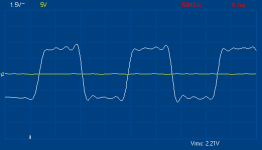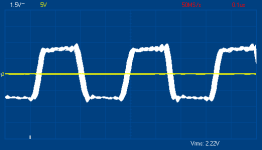This second image shows the same clock signal but with the "persistent trace" option active. Time base is again set to 100 nS/div.
Question:
Since the signal time drift stays within less than one third of a division, can I conclude that the clock signal has a jitter of about 30 nS peak-to-peak?
Best regards.
Pau
Question:
Since the signal time drift stays within less than one third of a division, can I conclude that the clock signal has a jitter of about 30 nS peak-to-peak?
Best regards.
Pau
Attachments
What you see on the screen of a scope is the jitter of the signal PLUS the jitter of the timebase. The latter may be much bigger than the signal being observed. Try NORM trigger (not AUTO), set the timebase so that you can see only one signal transition in the middle of the screen (the first transition is at the leftmost where the triggering takes place), set X10 horizontal deflection and find the signal transition with HORIZONTAL POSITION. Then you minimized the effect of the timebase and you can use it for quantitative comparison.
- Status
- Not open for further replies.

